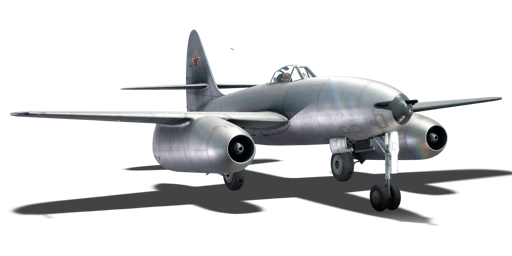



Towards the end of the Second World War, the USSR quickly began pursuing multiple jet-powered fighter projects to catch up to the western Gloster Meteor, Me-262, and F-80. One such project was "Aircraft K" from the Sukhoi design bureau, which was heavily influenced by captured German designs (namely the Me 262). The aircraft was originally conceived to use the new and upcoming indigenous Soviet jet engines being designed by Lyulka and Tumansky, however, due to setbacks on those programs, the aircraft plan was changed to instead use reverse engineered copies of the German Jumo-004 engine. The aircraft would bear the shape of the Me 262, but in reality, was almost completely different, having different weight distributions, wing design, tailplane shapes, and more importantly, a completely revised flap and airbrake system. This aircraft, now called the "Sukhoi Su-9", would finally fly in 1946 for the first time, where it was quickly revealed that the German engines were rather underpowered. The Lyulka TR-1 engines originally intended for the plane would finally be completed, however, it was revealed that mounting them required extensive redesign of the aircraft, which directly resulted in the Su-11 prototype.
The Su-9 was introduced in Update "Ixwa Strike". It is probably one of the better Soviet starter jets, as unlike the MiG-9, it is very forgiving in terms of manoeuvrability, and unlike the Yak-15, it is not limited by its low ammo count and top speed. The low velocity guns will take time getting used to, especially for players new to Soviet jets, but getting acquainted with the twin 23 mm and single 37 mm combo will prove fruitious as most Soviet jets for this rank and the next will have some variation of the same gun setup. All in all, the Su-9 acts as a great stepping stone from the propeller aircraft into the jet age of Soviet aircraft.
flaps
flaps
flaps
brake
| Belt | Belt filling | Armor penetration (mm) at a distance: | |||||
|---|---|---|---|---|---|---|---|
| 10 m | 100 m | 500 m | 1000 m | 1500 m | 2000 m | ||
| HEFI-T/HEFI-T/API-T | 49 | 47 | 39 | 32 | 26 | 21 | |
| HEFI-T/HEF-I/HEF-I | 6 | 6 | 5 | 4 | 3 | 3 | |
| API-T | 49 | 47 | 39 | 32 | 26 | 21 | |
| Belt | Belt filling | Armor penetration (mm) at a distance: | |||||
|---|---|---|---|---|---|---|---|
| 10 m | 100 m | 500 m | 1000 m | 1500 m | 2000 m | ||
| AP-I/FI-T | 32 | 30 | 22 | 15 | 10 | 7 | |
| FI-T/AP-I/AP-I/AP-I | 32 | 30 | 22 | 15 | 10 | 7 | |
| FI-T/FI-T/FI-T/AP-I | 32 | 30 | 22 | 15 | 10 | 7 | |
| AP-I | 32 | 30 | 22 | 15 | 10 | 7 | |












Flight performance | |
|---|---|
Survivability |
|---|
Weaponry | ||
|---|---|---|